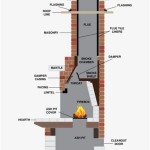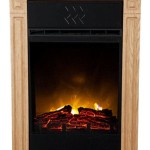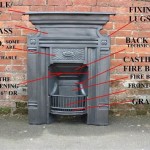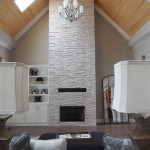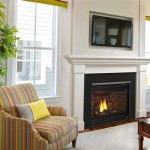Painted Brick Fireplaces: A Guide to Aesthetics, Preparation, and Maintenance
Brick fireplaces, traditionally celebrated for their rustic warmth and natural character, are increasingly being transformed through the application of paint. This design choice offers homeowners a versatile option to update their living spaces, allowing for seamless integration with diverse interior design styles. Painting a brick fireplace, however, is not simply a matter of applying a coat of color. It requires meticulous preparation, careful selection of paint types, and an understanding of potential challenges and maintenance considerations. This article explores the various facets of painted brick fireplaces, providing a comprehensive guide to achieving a successful and lasting aesthetic transformation.
The decision to paint a brick fireplace often stems from a desire to modernize a dated look, lighten a dark room, or create a more cohesive visual theme. Unpainted brick, while possessing inherent charm, can sometimes appear too traditional or clash with evolving design preferences. Paint offers the opportunity to introduce new textures, colors, and patterns, allowing the fireplace to become a focal point that complements the overall ambiance of the room. Beyond aesthetic considerations, painting can also serve a practical purpose by sealing porous brick and protecting it from dust and soot accumulation.
Key Considerations Before Painting
Before embarking on the painting process, several crucial factors warrant careful consideration. Failing to address these aspects can lead to unsatisfactory results, requiring costly and time-consuming rectifications. These considerations include assessing the condition of the brick, selecting the appropriate paint type, and understanding the potential impact on the fireplace's functionality.
The condition of the brick is paramount. Any cracks, chips, or crumbling mortar must be repaired before any paint is applied. These imperfections not only detract from the aesthetic appeal but also allow moisture to penetrate the brick, potentially causing further damage over time. Thoroughly inspecting the brickwork and addressing any structural issues is a critical initial step.
Choosing the right paint is equally important. Not all paints are suitable for brick, particularly those exposed to heat. Latex paints designed for interior walls are generally ineffective on brick fireplaces as they can blister and peel under high temperatures. Specialized masonry paints or high-heat paints are specifically formulated to withstand the extreme conditions associated with fireplaces. These paints often contain additives that enhance their durability, moisture resistance, and ability to adhere to porous surfaces.
Furthermore, consider the intended use of the fireplace. If the fireplace is frequently used, the paint needs to be exceptionally heat-resistant. Even if the fireplace is primarily decorative, the paint should still be able to withstand occasional exposure to heat and soot. Selecting a paint that is specifically labeled for fireplace use is always recommended.
Finally, consider the long-term maintenance requirements. Painted brick, especially in and around the firebox, can require periodic touch-ups due to soot accumulation and potential heat damage. Darker paint colors may show soot less readily, but lighter colors can brighten the space more effectively. Choose a paint color that aligns with your aesthetic preferences while also considering the practical implications of maintenance.
The Painting Process: Preparation and Application
Once the initial considerations have been addressed, the focus shifts to preparing the brick surface and applying the paint. This process involves several distinct stages, each crucial for achieving a professional and long-lasting finish. Proper preparation is arguably the most important step, as it ensures adequate adhesion and prevents future peeling or flaking.
The first step is thorough cleaning. Brick fireplaces accumulate dust, soot, and grime over time. These contaminants must be removed to allow the paint to adhere properly. Use a stiff-bristled brush and a solution of trisodium phosphate (TSP) or a similar degreasing cleaner to scrub the brick surface vigorously. Rinse thoroughly with clean water and allow the brick to dry completely before proceeding. This drying process may take several days, depending on the humidity and the porosity of the brick.
After cleaning, apply a masonry primer. Primer serves several important functions. It seals the porous brick, preventing the paint from being absorbed excessively. It also provides a uniform surface for the paint to adhere to, ensuring a consistent finish. Choose a primer that is specifically designed for masonry and follow the manufacturer's instructions for application. Allow the primer to dry completely before applying the paint.
When applying the paint, use a brush, roller, or sprayer, depending on the desired finish and the texture of the brick. A brush is ideal for getting into the nooks and crannies of uneven brick surfaces, while a roller can provide a smoother, more uniform finish on flatter surfaces. A sprayer can be used to achieve a textured or antiqued look. Apply multiple thin coats of paint, allowing each coat to dry completely before applying the next. This technique helps to prevent drips and ensures a consistent color saturation.
Pay particular attention to the mortar joints between the bricks. These joints can be difficult to paint effectively, so use a small brush to carefully apply paint to each joint. Avoid applying too much paint at once, as this can cause drips and runs. Instead, apply thin, even coats, working in small sections at a time.
Maintaining a Painted Brick Fireplace
Once the painting process is complete, ongoing maintenance is essential to preserve the appearance and integrity of the painted brick fireplace. Regular cleaning and touch-ups can prevent soot accumulation, address minor damage, and extend the lifespan of the paint.
Regular cleaning is crucial. Use a soft brush or vacuum cleaner with a brush attachment to remove dust and soot from the painted surface. For more stubborn stains, use a mild detergent and water solution. Avoid using harsh chemicals or abrasive cleaners, as these can damage the paint. Wipe the surface gently and rinse with clean water. Dry thoroughly after cleaning.
Touch-ups may be necessary over time, particularly in areas exposed to high heat or soot. If the paint begins to chip or peel, sand the affected area lightly and apply a fresh coat of paint. Use the same type and color of paint that was originally used to ensure a consistent finish. Apply thin coats of paint and allow each coat to dry completely before applying the next.
Consider sealing the painted brick to provide additional protection against moisture and stains. A masonry sealer can help to repel water and prevent the paint from fading or peeling. Apply the sealer according to the manufacturer's instructions. Reapply the sealer every few years to maintain its effectiveness.
Inspect the fireplace regularly for any signs of damage, such as cracks, chips, or crumbling mortar. Address these issues promptly to prevent further deterioration. Repair any damage before it becomes more extensive and costly to fix.
Finally, be mindful of the type of fuel burned in the fireplace. Certain types of wood can produce more soot than others. Using seasoned firewood and ensuring proper ventilation can help to minimize soot accumulation and reduce the need for frequent cleaning and touch-ups. Consider using a fireplace screen to prevent sparks and embers from damaging the painted surface.

30 Gorgeous Painted Brick Fireplace Ideas

7 Beautiful Ideas For Painting Interior Brick Fireplaces

Our Black Painted Fireplace Bright Green Door

Paint Your Brick Fireplace In 2 Easy Steps Birkley Lane Interiors

42 Painted Brick Fireplace Gorgeous Color

How To Paint A Brick Fireplace Kippi At Home

How To Paint A Brick Fireplace What Use Home With Janny

ᑕ❶ᑐ How To Paint Your Brick Fireplace For Home

How To Paint A Brick Fireplace For Less Than 150 Slay At Home Mother

How To Paint A Brick Fireplace

